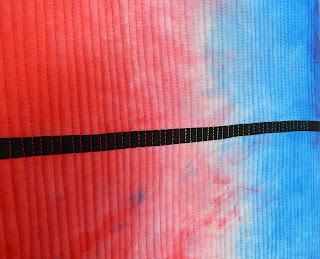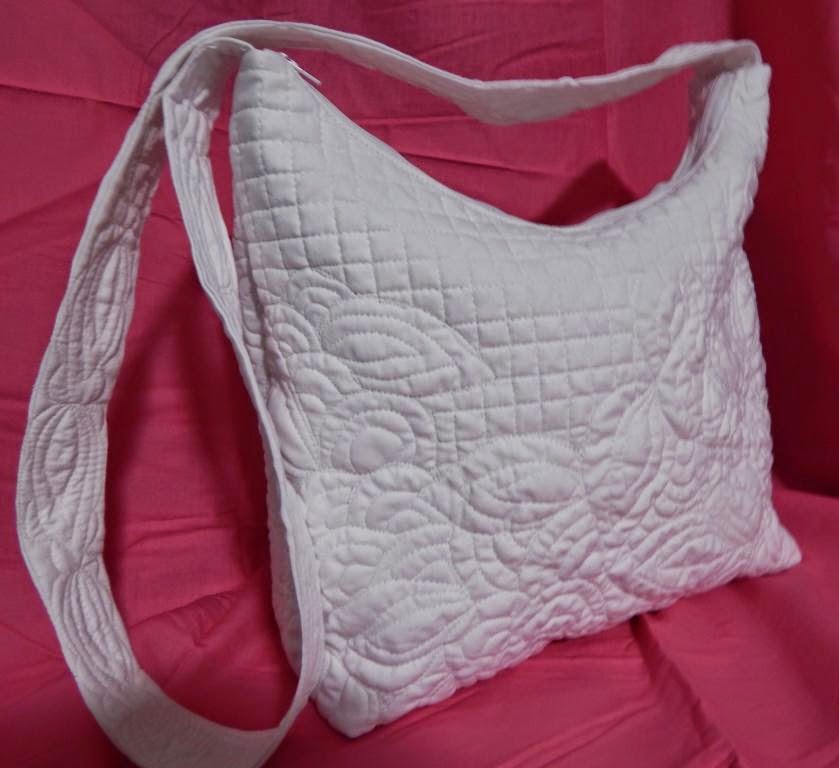I'm currently working on the quilting of this project, tentatively titled Edenic. As a member of the Monthly Art Project group on Facebook (https://www.facebook.com/groups/monthlyartproject/), I'm posting progress on this piece on the 15th of each month.
This top is pieced and about 44 x 56".
It's great to get something down off the design wall and under the needle.
Next month the plan is to finish up some other project that is too long on a design wall. Ultimately I hope to get 4 such projects well progressed this year.
Monica in Michigan
Monica Johnstone: Quilts & Textile Art
09 March 2018
30 August 2016
78.5 x 78.5 inches. Roman Glass by Monica Johnstone
Circular Abstractions: Bulls Eye Quilts is now at the Muskegon Museum of Art.
Catalogs can be sourced here
Circular Abstractions: Bulls Eye Quilts is now at the Muskegon Museum of Art.
Catalogs can be sourced here
Circular Abstractions
Exhibition Catalogue
now available for purchase.
WEBSITE: Use the PayPal link on the Store page of our website (
for U.S. shipped orders only.)
So delighted to be in this wonderful exhibit.
22 January 2016
Getting to “Congratulations”—from first ideas to finished products
Anyone who has given a quilt talk gets a couple questions that
are real chestnuts—how long did it take and where do you get your ideas. This post will get at both, I think.
After an enormous 16 month push resulting in acceptance of a
piece called Roman Glass (78.5” by 78.5”) to Circular Abstractions (juried and
curated by Nancy Crow, opens Aug. 25, 2016 at the Muskegon Museum of Art), I
realized that I’d developed a new way of working (at least it was new for me) that
suited me and also fit with a rather germinal plan I had to do a series of
quilts about ancient objects.
Not long after that project was completed, Brenda Gael Smith
announced her next travelling exhibition on the theme ”a matter of time”. Though only one entry by any one artist would
be accepted, she allowed multiple entries.
I’d had a quilt in the first of her exhibits ( Beneath the Southern Sky)
and though I entered two quilts in her next one (Living Colour), neither was
selected. I saw both exhibitions and
know that there was no way either of my entries to LC would have worked. Brenda has a wonderful eye for color and flow
and her exhibitions absolutely sing.
So for round three (a matter of time), I was determined to
be as on key as possible. I decided to
work on three of the ideas that announced themselves to me most clearly. There were some others but they didn’t insist
on being made. I also consciously avoided anything I presumed others might do--so for me that meant to stay away from clocks, trees, the faces of elderly people and other motifs that others might pick and would probably execute better than I would (as these don't tend to be ones that I've gravitated toward in my quilts).
I tend to work from intellectual ideas that interest
me. Are you shocked? Doesn’t everybody say they “work from nature
and observation”? Nope, I am an academic
at heart and studied Latin and Greek at school and have a huge interest in
metaphor and literature—so my ideas come out of my head rather than in through
my eyes most of the time--at the beginning of the process in any case. The other place
ideas come from is the desire to try out an effect. For instance, I’m a quilter who needs to know
how they do that whether it is a Y seam or the illusion of glowing through color
placement.
The first entries in the sketchbook show that the idea that
works out is sometimes the very first one to hit you—but it is rarely as
refined as it needs to be. As the photo
shows, I sketched an amphora which was slightly off center and touched top and
bottom of the frame. This would become
Patina: Ancient Amphora.
Next to it is the
first germ of the idea to have a bit of central red, black on one side and
white on the other, quilted in top to bottom straight-ish lines. You could say that this eventually split into
both of the other ideas that I would see to completion.
Here are the two that eventuated from that second idea.
 This one is Red Shift: A Matter of Time and Place. Hand dyed, then sprayed to punch up the color further. It is quilted in 8 colors of 28wt Aurifil.
This one is Red Shift: A Matter of Time and Place. Hand dyed, then sprayed to punch up the color further. It is quilted in 8 colors of 28wt Aurifil. This one is called This Red Hot Moment. I was quite happy to get that center to glow. One early test had one slightly greyed orange in the mix and, boy, that put the fire right out. I was also feeling pretty clever when I needed one extremely pale pink and achieved it through layering a less opaque white fabric over a light pink.
This one is called This Red Hot Moment. I was quite happy to get that center to glow. One early test had one slightly greyed orange in the mix and, boy, that put the fire right out. I was also feeling pretty clever when I needed one extremely pale pink and achieved it through layering a less opaque white fabric over a light pink.
Patina was more complicated. Elaborate improvisational piecing using Kona solids, silk, peppered cottons, paint stick on cotton, and a much more elaborate quilting pattern (researched from ancient amphorae and other Greek and Roman ornament--and then a heap of improv, poly and metallic thread.
[Side note--I actually sewed through my left index finger making this quilt. I was sewing an area with heavy seam overlaps and the machine balked and my hand lurched and, well, let's just say that it was lucky I was at a quilt retreat with a former school nurse (thanks, Donna!).]
And how long does it take? Well, less than the time to put a patina on bronze, but more than my full-time career easily affords me so the holiday break had a lot less to do with preparing turkeys and far more to do with sitting down at my APQS George to quilt. I made about half of the fabric for Patina at a three day retreat (but punctuated with some side projects so it was not three continuous days on that project).
Want to know more? Follow #amatteroftimetextiles, the facebook page, or the website.
27 August 2015
ArtPrize 2015
Today I will be taking my ArtPrize entry to the curator. I'm taking it rolled, so I made a muslin cover for a pool noodle, held it together with two wide muslin straps applied loosely enough not to make a mark but snug enough to keep the roll together as it is inserted into a muslin bag made for the purpose.
I decided that french seams made sense to limit the stray threads that might cling to the work.
I find that remnants of extra-wide muslin is quite good for making this packaging.
I decided that french seams made sense to limit the stray threads that might cling to the work.
I find that remnants of extra-wide muslin is quite good for making this packaging.
24 August 2015
"Roman Glass" was juried in!
CIRCULAR ABSTRACTIONS: BULL’S EYES QUILTS
Grand Opening: August 25, 2016
August
25-November 6, 2016
Juried by Nancy Crow
Muskegon
Museum of Art
296
W Webster Ave
Muskegon,
MI 49440
tel:
(231) 720-2575
I'm very excited to be part of this 50 work exhibit!
22 September 2014
In love with the APQS George
One month in, it is safe to say that I'm in love with the George. I've been able to deal with different threads, the height of the table and great lighting means I don't sit in a strange way so my back feels fineeven after a pretty long session, and my husband and son say they don't even hear it when watching tv in the next room.
To get better fast, I'm trying to quilt every day and re-read my books by Diane Gaudynski, Leah Day, et al. Self-imposed boot camp! I decided that in addition to making test pieces, I might as well make some actual things.
To get better fast, I'm trying to quilt every day and re-read my books by Diane Gaudynski, Leah Day, et al. Self-imposed boot camp! I decided that in addition to making test pieces, I might as well make some actual things.
28 July 2014
By value
Somehow it seems intuitive to sort fabric by color, but now that I've been at this longer, I listened to the very good advice of Maria Elkins to sort my fabric in preparation for my next class with Nancy Crow by value. I'm taking 4 "under the bed" style boxes, so Saturday I sorted by 4 value ranges (very light, medium-light, medium-dark, dark). As Maria points out, in a box full of lights, it isn't hard to spot a particular color.
This didn't take very long because I had a cardboard value finder. I may go back later and set my camera to black-and-white mode in order to spot some of the borderline cases so that I can refine my sort.
I'm taking a photography for textiles class soon and this photo is a good reason why. My darks came out looking like medium darks (on the left) and they really are much deeper colors than that. This flash photo really bleached the darks out considerably. I'm looking forward to getting better at this!
This didn't take very long because I had a cardboard value finder. I may go back later and set my camera to black-and-white mode in order to spot some of the borderline cases so that I can refine my sort.
I'm taking a photography for textiles class soon and this photo is a good reason why. My darks came out looking like medium darks (on the left) and they really are much deeper colors than that. This flash photo really bleached the darks out considerably. I'm looking forward to getting better at this!
Subscribe to:
Comments (Atom)












